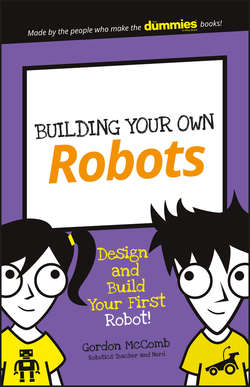Читать книгу Building Your Own Robots - McComb Gordon - Страница 2
На сайте Литреса книга снята с продажи.
INTRODUCTION GET STARTED WITH ROBOT-BUILDING
ОглавлениеWELCOME TO THE WORLD OF ROBOT-BUILDING! When I was a kid I saw a scary movie about robots. But instead of being afraid, it made me want to build my own “mechanical man.”
My very first robot wasn’t a robot at all – it was just a tin can with wires sticking out the top. But it started me on a lifelong journey of building stuff that moved and blinked … some of my robots have even walked and talked.
ABOUT THIS BOOK
Robot building isn’t just one skill, it’s a whole lot of them.
In order to build a robot, you have to learn how to use tools, craft new things out of existing parts or raw materials, apply basic concepts of electricity to motors and switches, plus much more.
Building Your Own Robots helps teach you these and other core concepts, while showing you how to construct four different fun and interesting robots. Each of the four projects in this book is designed to be inexpensive, and they each require no more than two hours of building time. Special tools aren’t needed.
You’ll discover things like:
Understanding the important parts of a robot
Making robots from discarded toys and common household materials
How to use small motors to make your robot creations m-o-v-e
Using batteries to power your robot
Everything is designed for kids. None of the building plans require using sharp or dangerous tools. (Still, be sure to read and follow all the safety guidelines provided!)
What this book isn’t about: Sorry, this book won’t teach you how to build your own R2-D2 or C-3PO. Those kinds of robots are far more complicated than what can be explained here.
But when you’re done with this book, and you want to discover more, don’t stop! See “Finding the Stuff to Build Your Robots,” at the back of this book, for a list of resources for continuing your robot-building education.
BASIC TOOLS AND SUPPLIES
Here’s what you need to do the projects in this book:
Some common household tools, including scissors, a small screwdriver, and a pair of needle nosed pliers. Don’t worry – each project details the specific tools you need to complete the robot.
A low temperature hot glue gun and a spool of black electrical tape.
Some discarded toothbrushes, toys, and other household items, raided for their parts. If you don’t already have these hiding somewhere in your closet, you can find them easily enough at garage sales and resale stores. They also are cheap to buy new.
Insulated wire – when the time comes, I’ll tell you exactly what kind.
Foam board (the stuff you make school projects with) or thick cardboard cut from a shipping box.
Small toy hobby motors. Get these from junk stuff, or buy new. They’re cheap.
Quarter-inch (outside diameter) clear aquarium tubing, for making tiny tires. Get it at pet-supply stores and most home improvement outlets.
ABOUT YOU
Any book with projects has to make a few assumptions about the folks who read them. To get the most out of this book, my assumption is that you have:
Some basic familiarity with using simple tools – screwdrivers, scissors, and hot melt glue guns for crafting.
Some familiarity with making simple things out of adhesive tape, glue, thick cardboard, and foam boards. You don’t need to be an expert; this book will help you improve your skills.
Patience. This is this most important skill you need to successfully – and happily! – build your own robots. Go slowly, and enjoy the experience. Don’t rush!
FOR PARENTS
The projects in Building Your Own Robots are designed so that most children 7 and older can reproduce them without significant parental supervision.
All four projects include “Going Further” sections that cover intermediate topics found online. For some of these, parental guidance is highly recommended.
The steps in these “Going Further” sections are completely optional and are not part of the basic project. Instead, use them as “extra credit” for enjoying the exploration of science and technology with your child or student.
ABOUT THE ICONS
You’ll encounter a few picture icons as you read through the projects in this book. The icons point out different things:
Discover great ideas and time-saving shortcuts with the Tip icon.
Proceed with caution! This icon warns you of potential mistakes that could result in project failure, lost time, or even damage to your robot.
The Remember icon reminds you of great concepts you’ve encountered before and should keep in mind while building.
Okay, then. Let’s get started!
